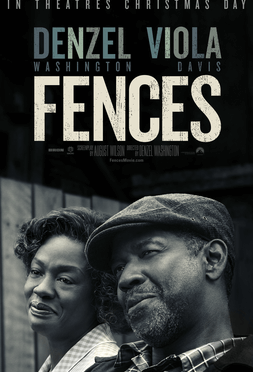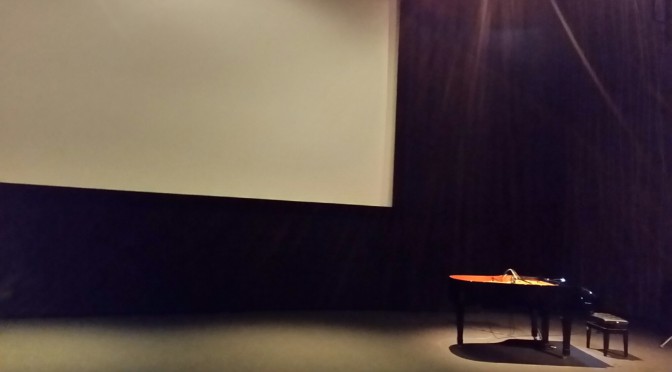I’ve written about music and film a couple of times before and although Denzel Washington’s latest film Fences is not about music and in fact has very little music in it, walking out of the cinema I thought it was an experience I’d like to share. Music has a role in the film as well, but it was the experience of watching this film in a sold out hall that I’d like to focus on here. This is also why I’ve included this post in the Gigs category.
One of the scenes, that for me came closest to an experience I usually have in concerts, didn’t have music playing at all. The film, however, is a good example of effective use of music in ways that serve the story – or are a part of it. But most of all I was reminded that watching a film in cinema is a social event, however little social interaction there might be – which is often preferable.
Fences is a story of a working class African American family trying to get by the best they can in a 1950’s post second World War but pre-Civil Rights Era suburban town. The main character is a man played by Denzel Washington who’s taking his role as the head of his family very seriously but, although he loves his family, he thinks it’s enough – or doesn’t know better than – to show it by providing them with material well-being to the best of his abilities.
Music first enters the story as the main character Troy’s eldest son walks in the house to borrow money. The son is trying to make a living as a musician and his father doesn’t approve. Although, as discussed before, music has provided professional opportunities to many African Americans, it’s been an uncertain bread bringer at bes and not a much more respected profession African Americans than it has in the mainstream society.
Watching together – Silence
As said, most of the film doesn’t have music at all. The “musical” experience I mentioned above was a moment in the scene, a part of which you can see in the trailer above, in which Troy is telling some very unpleasant news to his wife (I don’t want to spoil this for those who haven’t seen the film yet). Once he’s spilled out the words there’s a long silences as the words sink in, as much for the wife hearing the news, Troy waiting for her reaction and the audience watching the drama.
This intense moment of silence reminded me of my favourite moments in concerts; the endings of a performance where the whole hall – or whatever performance space – in intense stillness hangs on the last sounds as they fade away. In such moments one can kind of feel time. Every passing second, as the sounds fade, we come to terms with the performance we’ve witnessed and (hopefully) appreciate the efforts the artists have made to create it for us. In the scene of Fences I described above, the tension of between the characters was palpable as the sold out hall of around 100 people were sitting in silence and living the moment with the characters on the screen.
Like all performances, such moments are unique. Although this film is exactly the same every time it’s projected, the audiences are different. I’ve noticed it lately to be quite rare that audiences have the patience to keep quite in such moments. This can be also heard in the clip below (at 5’20”) where after the solo performance of Lars Danielsson starts to clap while the last notes are still ringing.
Music in storytelling
In Fences, music proper only enters the story after the above described scene; after the story takes a turn in the Golden Cut. We see Troy in blue thoughts at the bar while Dinah Washington sings You Don’t Know What Love Is (“until you’ve learned the meaning of the Blues”) in the background. Washington’s bluesy interpretation is a great choice, but also realistic as a contemporary of the story.
This scene also introduces Troy singing an old folk song Old Blue to himself, which helps bring closure to his relation to his youngest son in the end of the film. Again, I don’t want to disclose too much of the story not to spoil it for the “uninitiated” 😉
Troy sings Old Blue as an unaccompanied Blues, whereas all the versions I could find of it are in more country or American folk style. In Troy’s Blues rendition the dog of the story seems to be himself, which in the end his youngest son also realises helping him to make peace with his father.
Thus, in Fences we have music being part of the story – as it is part of life – in good and in (perceived) bad as well as accompanying life. Most impressive for me, however, was the performative similarity of the experience of that intense silence in the cinema. It takes a strong performance to capture an audience in a way that it stays silent for longer than 5 seconds and Fences, at least last night, it worked.
With various streaming services gaining popularity among music and film lovers alike, I find it good to keep in mind that there’s more to listening to music and watching films together as part of an audience, than individual pleasure of listening and watching art being performed while sitting on the coach at home and/or with headphones on. But more about this another time. While I think music will always be performed, with films it’s a bit different and we’ll have to see how things develop.
Meanwhile, go to movies! 😀



















